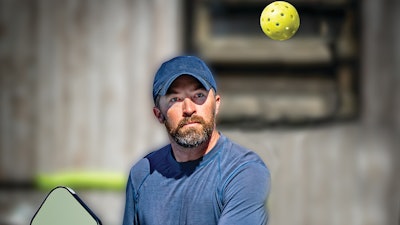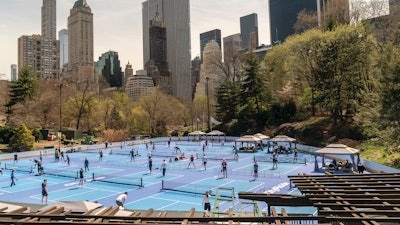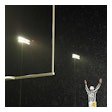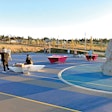
Nearly 3,500 pro and amateur pickleball players took part in a total of 6,928 matches over the course of the USA Pickleball National Championships in early November. The tournament, which took place at Brookhaven Country Club in Phoenix, Ariz., brought in more than 50,000 attendees, and 390,000 viewers tuned into ESPN during the hour-long broadcast of the final event. Collectively, over 2.6 million TV viewers tuned in during the tournament to catch over 20 total hours of coverage on ESPN, Tennis Channel and PickleballTV.
Those numbers speak to pickleball’s tremendous popularity right now. However, as with any young sport, pickleball has its share of wrinkles to iron, and one problem in particular demands a solution — it’s just too darn loud.
Quiet products
It’s no secret that pickleball has a noise problem. Search the internet for “pickleball noise” and you’re sure to find numerous news articles detailing how a homeowners’ association is suing a municipality over a noisy nearby court, or how a local parks department is trying to mitigate its court’s sound to placate annoyed neighbors.
They’re storylines with which Carl Schmits, managing director of Equipment Standards and Facilities at USA Pickleball, is very familiar. USAP took a proactive approach to the sport’s noise problem a few years ago, monitoring reports about complaints and litigation from across the country. In the end, the organization concluded that while noise was only a problem at a small percentage of the more than 11,000 operational facilities in the U.S., the sound generated by a standard pickleball paddle hitting a standard pickleball — at once the sound and bane of the brand — could inhibit the sport’s growth over time.
In 2022, USAP funded an extensive research effort to better understand the sound generated by the sport. “We really wanted to know whether it was an actual impact to a location, or if it was just the not-in-my-backyard trigger reflex,” says Schmits. “So, we started research with an external acoustic engineering firm to characterize the sound of the ball hitting a paddle.”
The results of that research were used as part of a broader initiative that would lead to the development of a set of specifications that USAP hopes will aid manufacturers in developing quieter products. In return for developing said products, the USAP can then certify and include the manufacturer’s products in its new Quiet Category, which will include all products that reduce acoustic output during play without negatively impacting performance.
Creating such meaningful two-pronged specs proved to be a challenge, admits Schmits. “It took us some time to land on both of those things, you know, what’s the number that makes sense and will still have an impact? And then what, from an engineering feasibility standpoint, can be accomplished to help support the goal of a quieter game?”
Schmits says USAP was cognizant of giving manufacturers some leeway, but doing so while still arriving at a specification true to the sport’s prevailing products was a balancing act. “With the first attempts at quiet products, the return of energy on the ball was maybe greater than the usual,” says Schmits, adding that paddle surface skin material could be considered sticky in some cases. “We weren’t comfortable with too wide a definition to reach those acoustic goals. We kept the specifications fairly close to a normal certified paddle, but there’s just enough design flexibility to try new things but still deliver an expected player experience.”
While quiet products will indeed lessen court noise, there’s no guarantee that casual players will buy them. The Owl CXE paddle, the first certified Quiet Category product, retails for $169. Meanwhile, casual players can pick up two standard paddles, a paddle bag, and a set of pickleball balls for under $60 on Amazon.
Schmits recognizes this as a potential barrier to adoption but notes that he’s already seen parks departments mulling plans to ensure that players use quiet products when appropriate.
“At NRPA, we had several conversations with essentially hotspots — courts that had been converted, or they’re under consideration for conversion from a basketball court or a tennis court — where there’s the potential of an issue,” explains Schmits. “The thinking there is using those lock boxes, not unlike what you see at big box stores, where you can go in and pick up your gear by swiping your ID. Imagine the only equipment that can be used in a pocket park or community park would be those quiet paddles stored on-site. You just slide your ID through that, and pull out your four paddles, and when you’re finished, you put them back.”

Understanding noise
Quiet Category paddles on every court would be the ideal, but unfortunately, we don’t live in an ideal world, and more extensive solutions will inevitably be needed.
Enter Bob Unetich, who has formed a reputation across the industry for being a bit of a guru when it comes to pickleball sound mitigation.
As Unetich tells it, he bought a condo in Florida back in 2015 and began playing pickleball at a nearby court. He was relatively new to the sport but nonetheless passionate about it, so when neighbors started complaining about the noise, he was more curious than defensive.
“The guy who was complaining, his back door was 168 feet away. I know that because I measured it,” says Unetich. “He just said it was too loud. He couldn’t take it. And so I started to get involved in the local pickleball club, which was concerned because they could lose rights to use the court.”
Unetich just happened to be the only engineer on the board of the club, so he took it upon himself to specialize in the “sound problem.” After reviewing recommendations from a third-party consulting firm, Unetich decided that the best way to proceed was to erect a 12-foot barrier between the courts and the neighborhood. After obtaining the correct permits, the courts were expanded by 5 feet and the barrier was erected. What happened next would essentially launch a second career for Unetich.
“People from other communities would come to see it, because they were having sound problems, too,” he says. “Most of the communities in Florida were saying, ‘Where could we put some courts?’ They were coming to visit, and I was doing a fair amount of that, and even that was getting to be a little too much. But then people started going back up north at the end of the season, and then they were calling from Milwaukee or Chicago or Boston, and they’d say, ‘Well, now we’re thinking about trying to put some courts up here.’ ”
As a result of all the interest, Unetich started his own consulting company, Pickleball Sound Mitigation LLC, which now has a lab where paddles and balls are tested, and the company uses special software that can predict exactly how that iconic sound will impact almost any environment. “We look at a site using Google Earth and consider what the sound is going to be. The sound is pretty much the same wherever it is, but it’s affected by objects that the sound hits — whether it’s hills or houses or cars,” Unetich says. “But I know what the sound level is, so I figured out how to embed that into my model and predict what the sound level would be in any community. I can just use the software, drop a sound source into any spot, and I can predict what the sound levels will be at the local homes. And if you put up a barrier, where it will drop, too.”
When considering what type of barrier might be needed at any given facility, Schmits emphasizes that no two cases are alike. “This is really an equation,” he says. “It’s not just a distance from a residence. It’s not any one variable. You have to look at so many things. Is it hardscape or a lake between the facility and the houses? Is it soft and absorbent? Is the facility higher or lower than the surrounding property? Elevation is important, prevailing wind — there are so many variables.”
To that end, Schmits recommends starting with a goal in mind. “How quiet does it need to be at the edge of the residential property, or at the edge of the facility’s property? You start with that, and then you reverse engineer. You factor in the distance, of course, if it’s the known location, and then you look at all those other variables.”
Schmits says USAP is currently recommending four technologies, including suspended acoustic foam, sound-attenuating fabric, mass-loaded PVC, and more recently a modular system being tested in the northeast that has varying panels of vinyl that are loaded with absorbent mineral wool. “And then there’s even clear panels for municipalities to install, so that they can do a law enforcement drive-by or a park ranger drive-by and see inside, you know, from a safety and security standpoint.”
Ambassadors needed
At roughly 70 decibels, a paddle hitting a pickleball generates a sound as loud as some alarm clocks — and many in the industry are answering the wake-up call. A pickleball referee, as well as a player, Unetich is now also a USAP-certified ambassador for the sport. He and others believe pickleball must solve its noise problem to be successful.
“I think pickleball players in particular should recognize that pickleball sound is a bona fide problem,” he says. “It’s not like just living next to a park where it’s something someone should put up with. It’s an annoying sound. The sound of an ordinary paddle is right in the range of backup beepers on garbage trucks, and those beepers were picked because they’re at the most annoying pitch. Sure enough, pickleball, by accident, has the most annoying pitch. But that’s where it is. And so I’m working on trying to pull the pitch down, try to pull the level down. I’m willing to work with anybody.”
Schmits says USAP has a rather standard set of recommendations for any community or municipality thinking about a conversion or greenfield pickleball facility, including conducting an acoustic study before breaking ground and getting the community involved as early as possible. “We don’t want to see the emergence of a not-in-my-backyard scenario, and we’re starting to hear that,” he says. “So we believe that this effort on the equipment side will help, as well as partnering with the architectural improvements — the panels that can go on the courts — and then lastly to consultancy. Upfront we will do a gratis initial acoustic simulation of the site for a parks and rec department.”
While Unetich and others in the industry can do a lot to help diagnose and treat the problem, Unetich says it’s going to take buy-in from the entire pickleball community to ensure the sport isn’t vilified by every HOA in the country that simply cannot abide the sport’s sound.
“This is a sport with like 9 million players, and only 100,000 people belong to the organization. That means 8.9 million don’t belong,” Unetich says, speaking as an official pickleball ambassador. “I think ambassadors are interested in growing the organization, and part of that is helping bring pickleball to others. So those ambassadors are going to help as they get more educated about this and more sensitive to it. You can’t just take a tennis court that’s right across the street from someone’s house and convert it to pickleball without expecting a sound problem. I mean, that’s the plain reality.”


































